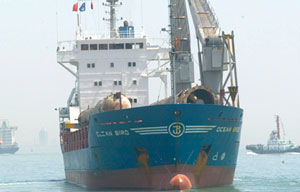ASIAN AUTOMOTIVE INDUSTRY
Wescast Heads East
No matter how much momentum other Asian countries may have, it's quickly subsumed by the continuing automotive surge in China, whether measured by total highway miles or total plant investments.
It's doubtful that the founders of
 |
| U.S. EXPORT TO CHINA? Yes, only in this case it was an entire hydrazine hydrate plant from German firm Lanxess, transported via five ships from Texas and inaugurated in the Chinese city of Weifang, in Shandong province, in July 2006. The chemical product is used in the automotive, pharmaceutical and agricultural sectors.
Photo: LANXESS AG |
Overall Wescast employs approximately 1,900 at six production facilities and at four sales and design centers located in Canada, the U.S., Japan and Germany. North American production plants are in Strathroy and Wingham, Ontario. The company's European production takes place in Oroszlany, Hungary. The company also has offices in Castle Donington, U.K.; Kassel, Germany; and Tokyo, Japan.
The company has just realized the first quarterly profit from its plant in Hungary, and is heading for China as its Brantford foundry closes down by mid- year 2006 as part of a "foundry capacity optimization plan." The Brantford foundry employed 340 at the time of the closure announcement in February 2005.
Jay McNaughton, vice president of strategic development for Wescast Industries, says a number of factors have influenced the decision to put a plant in China.
Using 10 criteria and a data- filtering process established by Tractus- Asia, Wescast narrowed the field for its plant from an original list of more than 400 economic development zones. Beyond the usual transport needs, McNaughton says one of the key factors was good power distribution, because of a foundry's typical high load demand. While memories of blackouts and lack of power capacity are not that distant in China, McNaughton says Wescast, like any other automotive company, expects reliability on the order of what it's used to in North America. That conforms to his firm's view of the long- term future in China, which is not "a flash in the pan."
"Economics 101 would dictate that things would equalize over time, so you have to instill excellence from the beginning," he says. "China has low labor rates, but I'd say over time, currency revaluations and inflation will compromise a labor- based model, so you have to employ global standards. The government is doing an amazing job. Whether it's a Chinese or international investor, they have to meet a certain level of standards and get approvals throughout the building process, and those levels are not all that different from what you and I would expect."
The same goes for human infrastructure: "You can't go in there thinking, 'I can put in a sub- standard facility,' and hope you'll retain people," he says. "The Chinese people expect a level of cleanliness and a humanistic working environment. Expectations are high from the Chinese worker. Go to Shanghai and it's like you're in New York – not just the hustle and bustle, but a certain standard of living. Many come over to Europe or North America for schooling, see how we live and want many of the same things."
Co- location with certain customers and central location relative to its entire customer base were also important to Wescast.
"China is big – it's not like you can be ideally situated for all," says McNaughton. "For us the key factor was access to good technical resources. Coupled with that was a competitive labor and wage structure."
After all factors were weighted in terms of their importance, the filtering process reduced the number of candidate areas to four, "which required some on- site investigation and verification of what had been garnered over the phone," says McNaughton. "That allowed us to re- rank priorities, key factors, and rank them relative to overall risk as well."
The next stage was financial analysis to "isolate the top runners" in terms of comparative profit and loss. Two finalists separated themselves from the field. Decision- making from that point forward, says McNaughton, was based on the areas' risk profiles, the financial benefits and incentives attached to each option and relationships. The latter was characterized by the ability to "work with local government officials in an ongoing way that allows you to conduct business in an efficient manner," he says. How those relationships will develop is not always easy to ascertain, says McNaughton, and comes "from the gut" as much as from the quantitative tools.

